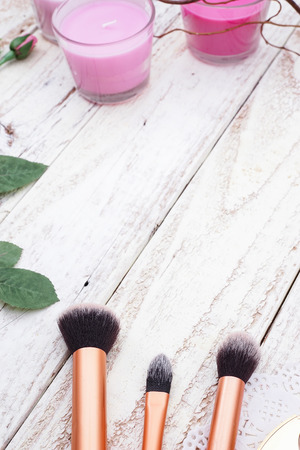Understanding Primers: The Base of a Flawless Look
If you’ve ever wondered why your makeup sometimes slips, fades, or melts away—especially after a brisk walk through the British drizzle—it’s time to get acquainted with primers. Primers are essentially the undercoat of your makeup routine. Think of them as the first line of defence against everything our unpredictable UK weather throws at you, from sudden rain showers in Manchester to a surprise heatwave in London. But what exactly are primers, what goes into them, and why are they so crucial?
What is a Primer?
A primer is a lightweight product applied after skincare but before foundation or tinted moisturiser. Its main job is to create a smooth surface for makeup, helping it grip better and last longer. For blokes just starting out, it’s not about caking on layers—it’s about smart prep that keeps you looking fresh and put-together all day.
Main Ingredients Found in Primers
| Ingredient | Purpose |
|---|---|
| Silicones (e.g., Dimethicone) | Smooths skin texture, fills in pores and fine lines |
| Glycerin | Hydrates and locks in moisture |
| Mattifying agents (e.g., silica) | Controls oil and shine—handy for humid days or oily skin types |
| Antioxidants & Vitamins | Protects skin from environmental stressors |
| SPF | Adds a layer of sun protection—essential even when it’s cloudy in Edinburgh! |
Why Primers Matter in British Weather
Let’s be honest—the UK climate isn’t always kind to your carefully applied face. One minute you’re battling wind and rain, the next you’re sweating it out on the Tube. A good primer acts like an anchor for your makeup, reducing patchiness caused by humidity or dryness and helping everything stay put, come rain or shine.
Key Benefits:
- Keeps makeup intact during unexpected downpours or muggy commutes.
- Minimises redness and irritation from harsh winds.
- Makes foundation application smoother and more even—ideal for achieving that natural, effortless look.
The Takeaway for Everyday Blokes:
If you want your grooming game to stand up to the elements—without constant touch-ups—a quality primer should be your go-to move. It’s an easy addition that makes a noticeable difference, especially when navigating the quirks of British weather.
Setting Sprays Explained: Locking in Your Hard Work
Let’s get into the nitty-gritty of setting sprays and what makes them a staple in any makeup routine, especially if you’re braving the unpredictable British weather. Unlike primers, which are all about prepping your skin, setting sprays are the final step designed to lock your masterpiece in place. The main job of a setting spray is to create a protective shield over your makeup, helping it resist smudging, fading, and transferring throughout the day.
Now, you might be wondering how setting sprays stack up against classic finishing powders. Here’s a quick breakdown:
| Setting Spray | Finishing Powder | |
|---|---|---|
| Main Function | Seals makeup for long-lasting wear | Reduces shine and sets foundation |
| Finish | Dewy, natural, or matte (varies by formula) | Usually matte, can look powdery if over-applied |
| Application | Mist over face as the last step | Dusted on with a brush after foundation/concealer |
| Best For | Locking in makeup; tackling humidity and rain | Controlling oil; smoothing texture |
If you’re living in London or anywhere with similarly moody weather—think sudden drizzles, humidity spikes on the Tube, or gusty winds along the Thames—a good setting spray becomes your best mate. Finishing powders can help control shine but might not stand up to that damp, sticky feeling after a sprint for the bus. Setting sprays, on the other hand, are formulated to keep your look fresh even when faced with drizzle or humidity. Some formulas even boast waterproof or sweat-resistant claims, making them perfect for both daily commutes and big nights out.

3. Comparing Benefits: Primers vs Setting Sprays
When it comes to getting the most out of your makeup routine, understanding the unique advantages of both primers and setting sprays is key. While these two products might seem similar at a glance, their roles are actually quite distinct, with each offering specific benefits that can make or break your look—especially if you’re after that all-day fresh finish on a busy day in London or braving the unpredictable British weather. Here’s a breakdown to help you decide where they overlap and where they stand apart:
| Primers | Setting Sprays | |
|---|---|---|
| Main Purpose | Create a smooth base and enhance makeup longevity by prepping the skin. | Lock in finished makeup, preventing smudging and fading throughout the day. |
| Application Stage | Applied before foundation and other face products. | Spritzed over makeup as the final step. |
| Key Benefits | Minimises pores, controls oil, hydrates dry patches, and evens out skin texture for flawless foundation application. | Seals makeup, reduces transfer (great for mask-wearing on the Tube), and offers a refreshing boost—some even provide extra hydration or mattifying effects depending on formula. |
| Where They Overlap | Both aim to extend makeup wear and improve overall finish, but approach it from different angles—primers work beneath, while setting sprays protect from above. | |
| Main Differences | Focuses on skincare-like prep and targeted concerns (oiliness, dullness, redness). | Acts as a protective shield against external factors like humidity or rain—a must in the UK! |
In essence, primers are about creating the ideal canvas before you start painting, while setting sprays act like a topcoat to lock everything in place. For those who commute daily or spend long hours at work or out socialising in ever-changing British conditions, using both can be a game-changer. However, if you have specific concerns—like oily skin or need your look to last through an evening at the pub—choosing one tailored to your needs can still deliver solid results. Ultimately, it’s all about finding what fits into your lifestyle and delivers the performance you expect from your makeup routine.
4. Common Misconceptions in the UK Market
When it comes to primers and setting sprays, there are a few myths that seem to float around British makeup circles—whether thats at the pub, in beauty forums, or among mates on a night out. One of the most common beliefs is that using both a primer and a setting spray is overkill, especially for those who prefer a natural look or don’t wear heavy makeup daily. But is this really true? Lets break down some key misconceptions:
| Myth | Reality |
|---|---|
| You only need one: either primer or setting spray, not both. | Primers prep your skin for smoother application and extended wear, while setting sprays lock your look in place—each has a unique role. |
| Setting sprays are just fancy water; they don’t do much. | Most modern formulas go beyond hydration; they can mattify, add radiance, or even protect against pollution (very handy in cities like London or Manchester). |
| If you’re not wearing full glam, you can skip both products. | Even minimal makeup benefits from longevity and a polished finish—think of all-day meetings or unpredictable British weather! |
It’s also worth noting that many British men who are new to makeup might assume these steps are only for women or special occasions. In reality, anyone looking for a fresher appearance (and less shine during those surprise video calls) can benefit from incorporating at least one of these products into their routine. So, whether you’re running errands in the drizzle or heading to an after-work pint, understanding the real function of primers and setting sprays helps you make smarter choices—without falling for the hype.
5. Day-to-Day Routine: Do You Really Need Both?
If you’re living in the UK, your makeup needs to keep up with more than just unpredictable rain and the odd gust of wind. For blokes who care about looking fresh at work or those heading out for a cheeky pint, understanding whether you need both primer and setting spray is about practicality as much as polish. Let’s break it down for the everyday routine, factoring in British lifestyle, weather, and social habits.
Primers vs Setting Sprays: The Everyday Breakdown
Most mornings are a rush—quick cuppa, throw on an outfit, maybe a five-minute face if you’re lucky. Here’s how each product fits into daily life:
| Scenario | Primer Needed? | Setting Spray Needed? |
|---|---|---|
| Commuting (bus/tube/cycle) | Yes, helps prevent sweat and oil build-up | Optional, useful if you’ve got meetings after work |
| Office/Indoor Work | Light primer for even skin tone | Only if you want extra longevity for after-work plans |
| Pubs/Social Evenings | If you applied makeup in the morning, a touch-up primer stick works wonders | A quick spritz keeps things fresh through the night |
| Active Days (Gym, Football) | No need unless you want to hide redness or blemishes | No need unless you’re going out straight after |
So, Do You Really Need Both?
For most lads and makeup lovers in the UK, using both every single day isn’t essential—unless you’re after that flawless Instagram finish from morning till midnight. A good rule of thumb: on standard days, pick one based on your main concern. If your skin gets oily by lunchtime (especially during humid spells), go for a mattifying primer. If you need your look to last from work to drinks without slipping off your face—even in classic British drizzle—a setting spray is handy.
The Practical Approach
Think of it like this: primer is your base coat for smoothness and grip; setting spray is your finishing touch for lasting power. On most days, especially with our British climate swinging from chilly winds to summer heatwaves, choose what fits your lifestyle best. Save both for special occasions—weddings, big nights out, or when you want that extra confidence boost.
6. Expert Tips: Making the Most of Your Products
To get the best out of both primers and setting sprays, its essential to know how to layer and combine them effectively. Top British makeup artists like Lisa Eldridge and Charlotte Tilbury swear by specific techniques that make all the difference between a flawless face and a fading finish. Here are some insider tips to help you master your routine:
Layering Like a Pro
Applying your products in the right order is key. Start with a clean, moisturised face, then follow these steps:
| Step | Product | Technique |
|---|---|---|
| 1 | Primer | Apply with fingers or a brush, focusing on areas with larger pores or where you need extra hold (usually the T-zone for most Brits). |
| 2 | Foundation/Makeup | Let your primer set for a minute before applying foundation with a sponge or brush for an even base. |
| 3 | Setting Spray | Mist lightly after makeup application, holding the bottle about 20cm from your face. Let it air dry – don’t pat it in! |
British Makeup Artist Picks & Techniques
Loved by British pros, pairing hydrating primers with matte setting sprays works wonders for unpredictable UK weather. Lisa Eldridge often recommends using an illuminating primer on dull days, while Charlotte Tilbury’s tip is to use a pore-blurring primer before big events and lock everything in place with her Airbrush Flawless Setting Spray.
- For oily skin: Go for mattifying primers and oil-control setting sprays – top picks include Rimmel Stay Matte Primer and Urban Decay All Nighter Setting Spray.
- For dry skin: Hydrating primers like No7 HydraLuminous and dewy setting sprays such as Iconic London Prep-Set-Glow keep skin fresh throughout the day.
- Natural finish: Try mixing a drop of liquid highlighter into your primer for that signature British “no-makeup” glow, then seal it all in with a lightweight spray.
Extra Tips for Longevity
- If you’re heading out for a long day in London or Manchester, carry a mini setting spray in your bag for quick touch-ups.
- Avoid over-applying either product; too much can cause pilling or a cakey look—less is definitely more here.
- If you wear glasses, dab extra primer around the nose bridge to prevent makeup transfer.
The Takeaway
By layering your products thoughtfully and choosing formulas suited to both your skin type and the ever-changing British climate, you’ll enjoy makeup that looks fresh from morning till night. Don’t be afraid to mix brands or try trending artist favourites—sometimes finding your perfect combination is half the fun!


